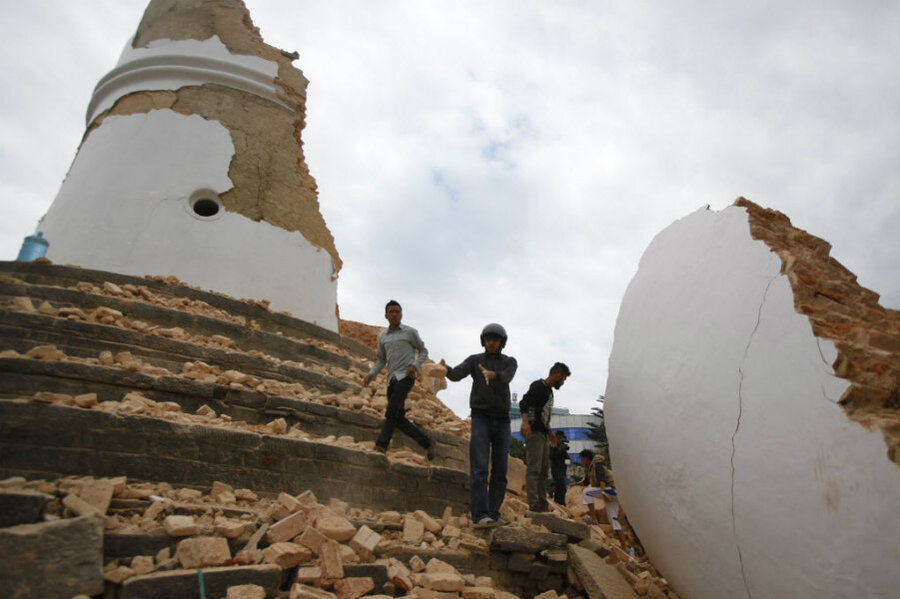Why Nepal gets such big earthquakes
Loading...
A 7.8 magnitude earthquake that struck less than 50 miles from Kathmandu rocked Nepal Saturday, leveling buildings and killing more than 1,000 people, according to reports.
The quake, which has triggered an avalanche on Mt. Everest and tremors felt in India, Tibet, and Bangladesh, is the worst to hit the Himalayan nation in 80 years. It puts to the test Nepal’s current preparedness to handle such a disaster, and once more brings disaster risk reduction programs and aid to the forefront of international discussion and scrutiny.
Nepal’s long history of seismic events is related to the movement of tectonic plates beneath the Himalayan mountain range – “one of the world’s most worrisome hot zones for earthquake risk,” The New York Times reported. At least 92 active faults have been mapped throughout the country, making the entire territory of Nepal a “high seismic hazard zone,” according to the nonprofit National Society for Earthquake Technology-Nepal (NSET).
"The Himalayan mountains are being thrust over the Indian plate; there are two or three big thrust faults, basically,” David Rothery, a professor of planetary geosciences at the Open University in the UK, told the BBC. “And some very gently dipping fault will have been what moved, and gave us this event.”
The country’s last great earthquake, which struck in 1934, had a magnitude of 8.0 and killed 16,000 people throughout Nepal and India. The quake also destroyed thousands of buildings, including the historic Dharahara tower, and crippled a quarter of homes throughout Kathmandu Valley.
A lesser quake hit eastern Nepal in 1988, killing 721 people. At least one earthquake equal to or greater than 5.0 on the Richter Scale has struck Nepal almost every year since, NSET reported in 2012.
The frequency of large quakes raises the risk for Kathmandu’s population, today at about 2.5 million.
“In terms of per capita casualty risk, the valley – as the area is known locally – is the most dangerous place in the world,” IRIN News reported.
The 10-year civil war that raged between the Nepali government and Communist separatists until 2006 did little to help development and risk-reduction efforts.
“The risk of exposure to natural hazards has been exacerbated by the fact that the country has only recently emerged from ten years of intrastate conflict,” Global Humanitarian Assistance, an international development initiative, reported in 2011. “It is still vulnerable and has a long way to go in terms of development. Lack of government capacity, weak infrastructure (roads, buildings) and over-population in urban areas, makes it difficult to reduce the risk.”
In 2011, as global concern for disaster risk reduction grew, the Nepali government partnered with a group of international organizations to create the Nepal Risk Reduction Consortium (NRCC).
The consortium’s goal is to promote the UN’s International Strategy for Disaster Reduction and work to reduce the country’s vulnerability to disasters by identifying five key, or flagship, priorities: School and hospital safety; emergency preparedness and response; flood risk management in the Kosi river basin; community based disaster risk reduction; and policy and institutional support for disaster risk management.
In 2013, the UN conducted a review of the NRRC that found that, although “much more work needs to be done” to close structure and capacity gaps within the program, the model was effective, overall.
The NRRC has helped create and retain a focus on disaster risk reduction and preparedness nationwide. It has enabled collaboration with the Government of Nepal’s largest and most influential development partners and donors. It represents a genuinely innovative case study for coordinated systems among humanitarian, development, national and government approaches.
That the tensions between various stakeholders’ approaches to risk reduction remained on the NRRC’s agenda also helped encourage viable solutions, according to the UN report.
Saturday's earthquake in Nepal is putting the government’s preparedness efforts to the test. So far, city hospitals have been overwhelmed by quake victims, while Kathmandu’s Tribhuvan International Airport has been shut down.
Both the United States and India have already pledged to send aid. International aid groups are mobilizing quickly. And there are reports of individuals and communities spontaneously organizing to search for and rescue those trapped in the rubble.
"We are treating it as a big emergency," said Ben Pickering, Save the Children's humanitarian adviser in Britain, told the Associated Press. "We know the damage is extensive and that access into rural areas will be very, very difficult for everybody."
Pickering said it is too early for a detailed assessment but that the overall picture is grim.
"Children will be affected in many ways. Physical injuries. Separated from families," he said. "The priority now is understanding the scale, what the emergency needs are right now and in the coming weeks."
Some charities are assembling disaster teams — based on the assumption that sanitation, shelter and medical help are urgently required — but the most convenient pathway into Nepal is not available because the international airport in Kathmandu has been shut down by the quake.
“Our emergency response team is en route to Nepal and we are prepared to help any way that we can,” said AmeriCares President and CEO Michael J. Nyenhuis. “This is a terrible tragedy and our hearts go out to the families suffering.”
An emergency response team from the AmeriCares India office in Mumbai is headed to the impact zone and relief workers are preparing shipments of medical aid and relief supplies for survivors.






